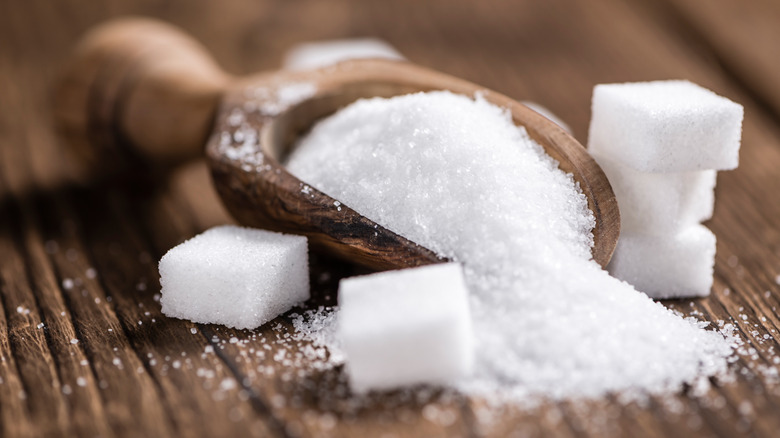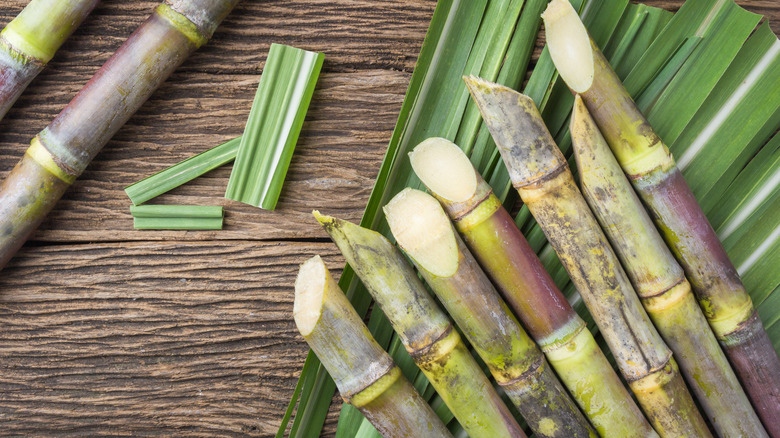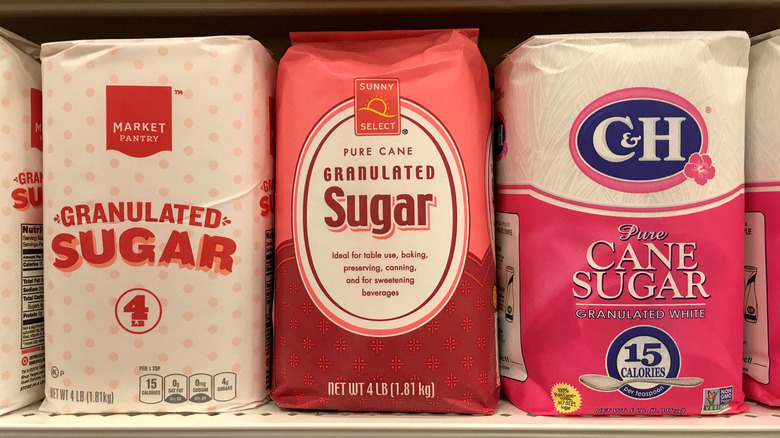What Is Bone Char And Why Is It In White Sugar?
Processed white cane sugar gets a fair share of shade, much of it well-deserved. But some of the most beloved edibles known to mankind center on sugar, from cookies, pies, and pastries to sorbets, chocolate truffles, fruit drinks, soft drinks, and even so-called savories such as ketchup, BBQ sauce, and protein bars. It slips into everyday eating like crystallized consumable diamonds we just can't resist. But there's one particularly startling thing about that white substance: It gets its pure snowy hue from something called bone char.
Before assuming that the "bone" refers to a color or texture rather than actual bone, take a deep breath. It's real bone, once attached to real animals, most of them residing in distant lands. Think Pakistan, India, Afghanistan, and the South American country of Argentina — where the bones originate and then journey westward via merchants in countries such as Scotland, Brazil, and Egypt.
Go ahead and beg the question: Why on earth (and all over the earth) would animal bones have anything to do with our sweet iced tea and morning doughnuts? There's actually a somewhat decipherable explanation for bone char. It's made from cattle bones and serves as a means of removing color from raw cane sugar, leaving it bright white and aesthetically pleasing.
How and why bone char works
Some in the sugar industry whitewash the term and the color-filtering process itself, calling it natural carbon rather than the more jarring reality of bone char. Still, certain processors eschew the practice in modern times. But plenty of refineries still process raw sugar cane with incinerated cow bones, so you can't exactly rest easy if the thought of crushed bones haunts your psyche.
Fortunately, you can close that gaping jaw of yours because bone char utilization is strictly regulated, at least in the USA and Europe. The cattle bones must come from abattoirs, otherwise known as slaughterhouses, and the animals are required to be free from cattle-related diseases, including BSE, otherwise known as Mad Cow Disease.
To get more precise about how the process works, Waste Management for the Food Industry in 2008 reported that bone char results from "the calcinations of bovine bones in the absence of air" (via Science Direct). When the bones go through incineration, it creates activated carbon, which is what aids in removing as much as 80% of the color from sugar cane. Plain old charcoal isn't used because it doesn't have the same structural integrity as bones, so it's more likely to dissolve.
Thanks to super-high heat and the diligence of certified facilities, there's little danger of munching bone bits in your Rice Krispy Treats.
Alternatives to processed white sugar and bone char
If you just can't get past the imposing idea of cattle bones mingling with your bag of sugar, there are some options for sidestepping the bone-char process. Other types of filters in use by sugar companies include granular carbon or ion-exchange instead of bone char.
It can be difficult to determine the journey of particular bags of white sugar unless the manufacturer declares the absence of bone-char filtering. Major sugar companies are also likely to source products from multiple refineries. Your best bet for avoiding bone-char decolorization, though certainly not guaranteed, would be to purchase from vegan sugar companies or ones that are certified organic or non-GMO. You can also prioritize using alternative products such as sugar beets, turbinado sugar, raw cane sugar, or low-processed Sucanat.
What about brown sugar? Actually, most brown sugar is treated, potentially with bone char, since it's basically just white sugar with added molasses. Powdered sugar, also known as confectioner's sugar, is fair bone-game as well, consisting of the same white sugar mixed with corn starch. Anyone who wants purely vegan sugar should go for raw sugar, beet sugar, or even Sucanat.



